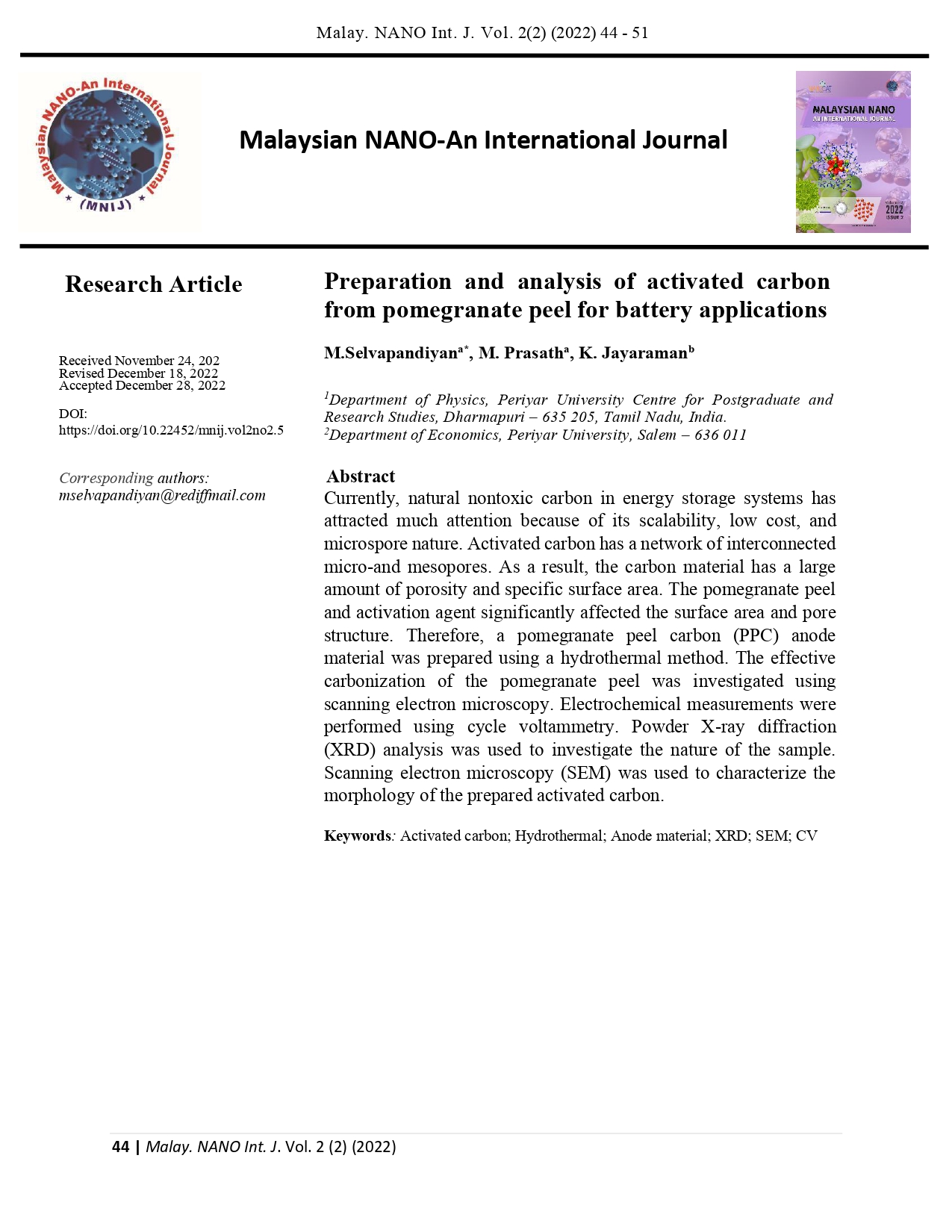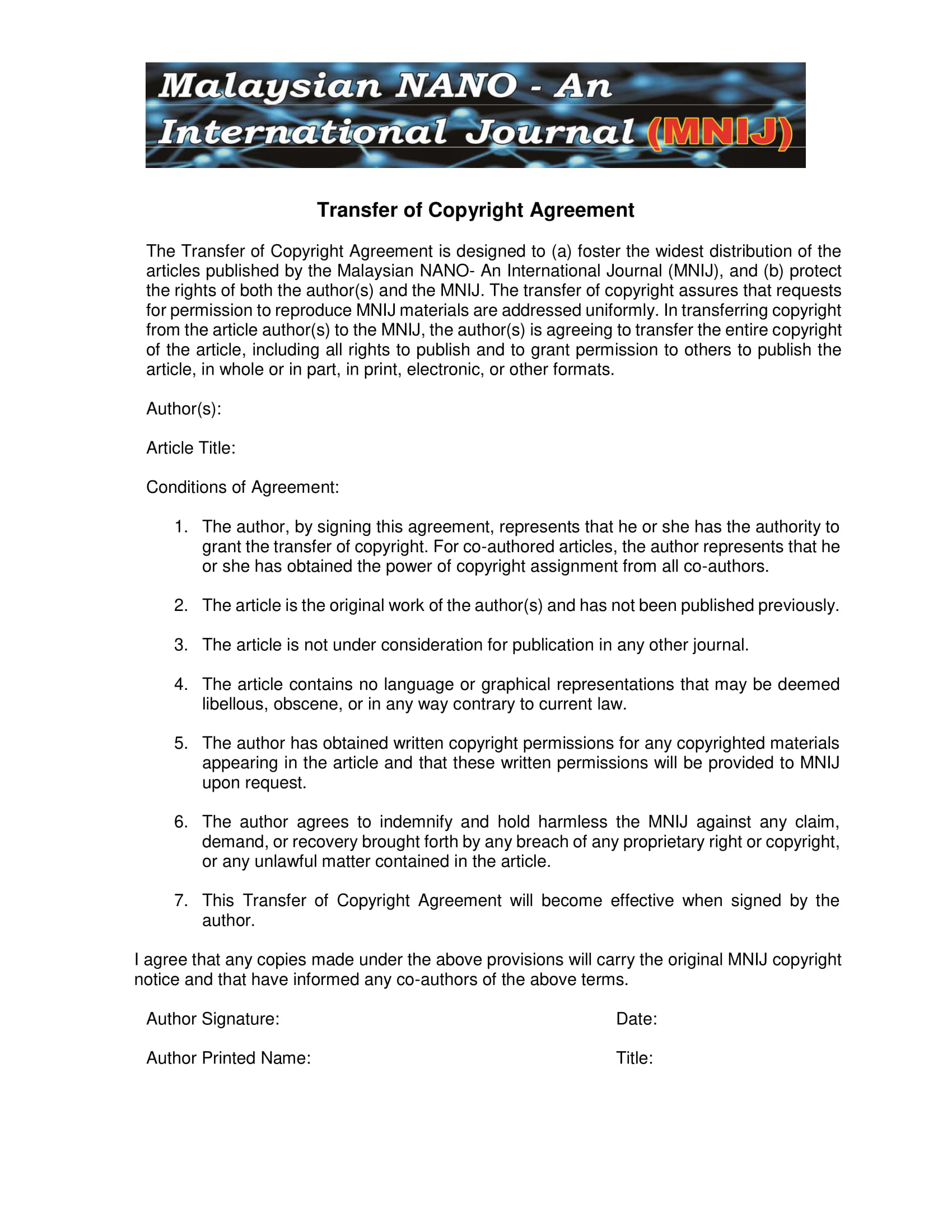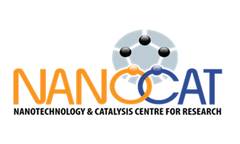Preparation and analysis of activated carbon from pomegranate peel for battery applications
DOI:
https://doi.org/10.22452/mnij.vol2no2.5Keywords:
Activated carbon, Hydrothermal, Anode material, XRD, SEM, CVAbstract
Currently, natural nontoxic carbon in energy storage systems has attracted much attention because of its scalability, low cost, and microspore nature. Activated carbon has a network of interconnected micro-and mesopores. As a result, the carbon material has a large amount of porosity and specific surface area. The pomegranate peel and activation agent significantly affected the surface area and pore structure. Therefore, a pomegranate peel carbon (PPC) anode material was prepared using a hydrothermal method. The effective carbonization of the pomegranate peel was investigated using scanning electron microscopy. Electrochemical measurements were performed using cycle voltammetry. Powder X-ray diffraction (XRD) analysis was used to investigate the nature of the sample. Scanning electron microscopy (SEM) was used to characterize the morphology of the prepared activated carbon.
Downloads
References
M.D.D. de Leon-Garza, E. Soto-Regalado, M. Loredo-Cancino, F.D. Cerino-Cordova, R.B. GarciaReyes, N.E. Davila-Guzman, J.A. Loredo Medrano. Phenol adsorption onto coffee waste - granular activated carbon: kinetics and equilibrium studies in aqueous solutions. Desalin. Water Treat. 2017: 90; 231- 240.
F.M. Kasperiski, E.C. Lima, C.S. Umpierres, G.S. dos Reis, P.S. Thue, D.R. Lima, S.L.P. Dias, C. Saucier, J.B. da Costa. Production of porous activatedcarbons from Caesalpinia ferrea seed pod wastes: Highly efficient removal of captopril from aqueous solutions. J. Clean Prod. 2018: 197; 919-929.
N.G. Rincon-Silva, J.C. Moreno-Pirajan, L. Giraldo. Removal of phenol, p-nitrophenol and pchlorophenol from activated carbon chemically with sulfuric acid from lignocellulosic waste material: Effect of the concentration of activating agent. Afinidad. 2017: 74; 112-123.
A.M. Abioye, F.N. Ani. Recent development in the production of activated carbon electrodes from agricultural waste biomass for supercapacitors: a review. Renew. Sustain. Energy Rev. 2015: 52;1282-1293
A. Kalair, N. Abas, M.S. Saleem, A.R. Kalair, N. Khan. Role of energy storage systems in energy transition from fossil fuels to renewables. Energy Storage. 2021: 3; 135.
Z. Li, D. Guo, Y. Liu, H. Wang, L. Wang. Recent advances and challenges in biomass-derived porous carbon nanomaterials for supercapacitors. Chemical Engineering Journal. 2020: 397; 125418.
S. Li, S. X.Tan, H. Li, et al. Investigation on pore structure regulation of activated carbon derived from sargassum and its application in supercapacitor. Sci Rep. 2022: 12; 10106.
Y.H. Cao, K.L. Wang, X.M. Wang, Z.R. Gu, Q.H. Fan, W. Gibbons, J.D. Hoefelmeyer, P.R. Kharel, M. Shrestha. Hierarchical porous activated carbon for supercapacitor derived from corn stalk core by potassium hydroxide activation. Electrochim Acta. 2016: 212; 839-847.
E.Y.L. Teo, L. Muniandy, E.P. Ng, F. Adam, A.R. Mohamed, R. Jose, K.F. Chong. High surface area activated carbon from rice husk as a high-performance supercapacitor electrode. Electrochim Acta. 2016: 192; 110-119.
W.T Tsai, T.J. Jiang. Mesoporous activated carbon produced from coconut shell using a singlestep physical activation process. Biomass Conv. Bioref. 2018: 8; 711–718.
A. Yürüm. "Sunflower Stalk Based Activated Carbon for Supercapacitors". Hacettepe Journal of Biology and Chemistry. 2019: 47; 235-247.
Z. Zhai, L. Zhang, T. Du, B. Ren, Y. Xu, S. Wang, J. Miao, Z. Liu. A review of carbon materials for supercapacitors. Materials & Design. 2022: 221; 111017.
V. Balasubramanian, T. Daniel, J. Henry, et al. Electrochemical performances of activated carbon prepared using eggshell waste. SN Appl. Sci. 2020: 2;127.
Phiri, Josphat et al. Highly Porous Willow Wood-Derived Activated Carbon for High-Performance Supercapacitor Electrodes. ACS Omega. 2019: 4;19; 18108-18117

Downloads
Published
How to Cite
Issue
Section
License





